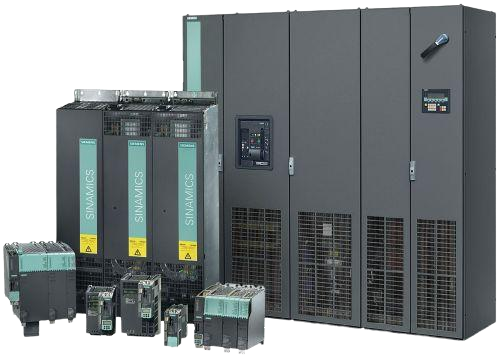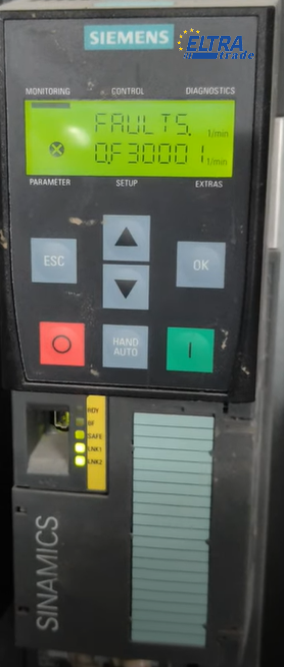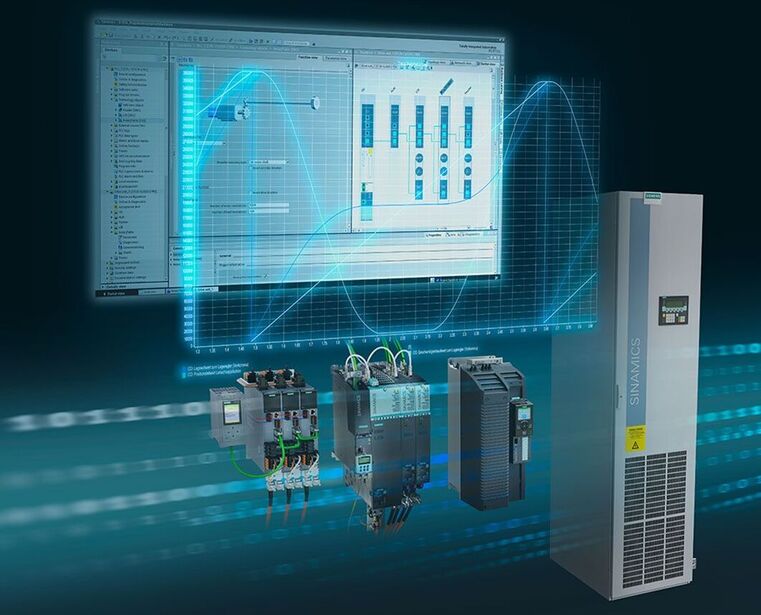Siemens AC Drive Fault Codes
23.08.2024
Efficiency and accuracy are crucial in industrial automation. Siemens AC drives offer the precise control required to accomplish these objectives. These drives give precise control over motor performance by varying the frequency and voltage applied to the motor. This is important for applications like conveyor systems, pumps, and compressors that need constant speed and torque.
Siemens AC drives are essential parts of industrial automation systems because they provide the foundation for managing electric motors, which power machinery in a variety of sectors. These drives are made to control the direction, speed, and torque of AC motors so that they run as efficiently as possible to satisfy the needs of contemporary production techniques.
Siemens AC Drive
Siemens AC drives are electronic devices that regulate the speed and torque of AC (alternating current) motors. They are often referred to as variable frequency drives (VFDs) or inverters. They are essential for many industrial applications because they provide increased accuracy, efficiency, and energy savings.
How Siemens AC Drives Work
- Incoming Power: AC drive receive AC power from the electrical grid.
- Rectification: The incoming AC power is converted into DC (direct current) using a rectifier.
- Inverter: The DC power is then modulated by an inverter, which transforms it back into AC power at a variable frequency and voltage.
- Motor Control: The variable frequency and voltage AC power is supplied to the AC motor, controlling its speed and torque.

Key Features and Benefits of Siemens AC Drives
- Speed Control: Siemens AC drives allow precise control of motor speed, enabling applications that require variable speeds, such as conveyors, fans, and pumps.
- Torque Control: They can also control motor torque, ensuring optimal performance in applications demanding constant torque, like cranes and elevators.
- Energy Efficiency: By adjusting motor speed to match the actual load requirements, Siemens AC drives can significantly reduce energy consumption, leading to cost savings.
- Improved Motor Protection: Built-in protection features, such as overload and short-circuit protection, help safeguard the motor and the drive itself.
- Enhanced Productivity: Siemens AC drives can improve overall system productivity by enabling smoother operation, reducing downtime, and increasing process efficiency.
- Flexibility: They are versatile devices that can be integrated into various industrial automation systems, providing flexibility in design and implementation.
Types of Siemens AC Drives
Siemens offers a wide range of AC drives to suit different applications and requirements, including:
- General-Purpose Drives: These are suitable for a broad range of industrial applications, offering a balance of performance and cost.
- High-Performance Drives: Designed for demanding applications that require precise speed and torque control, such as machine tools and robotics.
- Special-Purpose Drives: Tailored for specific industries or applications, such as HVAC systems, elevators, and wind turbines.
Fault Codes in Siemens AC Drives

Because Siemens AC drives offer exact control over motor speed and torque, they are crucial parts of many industrial applications. However, like any electronic device, they can experience faults. Understanding common fault codes, their potential causes, and effective corrections is crucial for minimizing downtime, optimizing system performance, and ensuring safety.
By promptly identifying and addressing fault codes, you can:
- Reduce downtime: Quickly resolving faults prevents prolonged interruptions to production processes.
- Prevent equipment damage: Timely intervention can prevent further damage to the drive or connected components.
- Improve system efficiency: Addressing faults helps maintain optimal drive performance and energy efficiency.
- Enhance safety: Faulty drives can pose safety risks if left uncorrected.
The table provides a list of master drive fault list, their potential causes, and suggested corrections.
| Fault Code | Fault Description | Causes | Solutions |
| F002 | Pre-charge error | No AC supply, faulty pre-charge resistor, faulty contactor | - Check AC supply |
| F003 | Motor overload | Exceeding permissible motor load, motor fault | - Reduce load |
| F005 | Drive overheating | Insufficient cooling, radiator contamination | - Check cooling system |
| F008 | Loss of communication with inverter | Communication cable issues, inverter fault | - Check communication cable |
| F011 | Low supply voltage | Unstable power supply, power source fault | - Check power source |
| F015 | High supply voltage | Exceeding permissible voltage, power source fault | - Check power source |
| F018 | Phase loss | Missing one of the supply phases, cable fault | - Check power cables |
| F019 | Inverter overload | Exceeding permissible inverter load, inverter fault | - Reduce load |
| F021 | Motor overheating | Insufficient motor cooling, fan contamination | - Check motor cooling system |
| F023 | Loss of communication with controller | Communication cable issues, controller fault | - Check communication cable |
| F025 | Temperature sensor fault | Temperature sensor fault, sensor cable break | - Check and replace temperature sensor |
| F027 | Current sensor fault | Current sensor fault, sensor cable break | - Check and replace current sensor |
| F029 | Memory module fault | Memory module fault, module cable break | - Check and replace memory module |
| F031 | Power module fault | Power module fault, module cable break | - Check and replace power module |
| F033 | Control module fault | Control module fault, module cable break | - Check and replace control module |
This table will help you quickly identify and troubleshoot common problems with Siemens AC drives.
Reset Siemens AC drive fault codes
Understanding and knowing how to reset AC drive fault codes is essential to keeping your equipment running smoothly. This allows you to respond quickly to problems and minimize downtime.
Manual reset procedures
Using the control panel (BOP or AOP):
Step 1: Check the fault code displayed on the screen.
Step 2: Correct the problem that caused the fault (e.g., check connections, replace defective components).
Step 3: Press the RESET button on the control panel to reset the fault code1.
Cycling the power off:
Step 1: Turn off the power to the drive.
Step 2: Wait approximately 5 minutes for all components to fully discharge.
Step 3: Turn the power back on. This should reset the fault code1.
Automatic reset functions
Automatic reset via drive parameters:
Step 1: Open the parameter menu on the control panel.
Step 2: Locate the parameter that is responsible for the automatic reset (e.g. parameter P0970 for some models).
Step 3: Set the parameter value to 21 for automatic reset2.
Using the setup software:
Step 1: Connect the drive to a computer using appropriate software (e.g. STARTER).
Step 2: Open the diagnostics menu and find the option for auto reset.
Step 3: Activate the auto reset function through the software3.
These procedures will help you to effectively reset fault codes in AC drive, ensuring uninterrupted operation of your equipment.
Preventive maintenance for Siemens AC drives
To guarantee dependable, long-lasting performance from Siemens AC drives, preventive maintenance is essential. Frequent maintenance lowers downtime, avoids malfunctions, and helps to detect possible issues early.
1. Visual inspection.
Check the external condition:
- Inspect the drive for visible damage such as cracks, dents, or corrosion.
- Make sure all covers and panels are in place and secure.
Check cables and connections:
- Inspect all cables for frayed, broken, or damaged insulation.
- Make sure all connections are secure and show no signs of corrosion.
2. Cleaning
Clean the air vents and heat sinks:
- Remove dust and dirt from the vents and heat sinks to ensure proper cooling.
- Use compressed air or a soft brush to clean.
Clean the internal components:
- If allowed by the manufacturer, open the drive and carefully clean the internal components of dust and dirt.
- Avoid using wet materials to clean electronic components.
3. Checking electrical parameters
Check the supply voltage:
- Verify that the supply voltage meets the drive specifications.
- Use a multimeter to measure the drive input voltage.
Motor current check:
- Measure the motor current during operation and verify that it does not exceed the allowable values.
- Note any abnormal current fluctuations.
4. Functionality test
Check drive operation:
- Start the drive and check its operation in all modes.
- Verify that the drive operates without noise, vibration, or other abnormalities.
Check safety features:
- Check the operation of all drive safety features, such as overload, overheat, and short circuit protection.
- Ensure that all safety functions are configured and working properly.
5. Software update
Check the software version:
- Make sure the drive is running the latest software version.
- Update the software if newer versions are available.
Back up your settings:
- Back up all drive settings before upgrading the software.
- Ensure that all settings are saved and can be restored if necessary.
Regular preventive maintenance of Siemens AC drives will help ensure reliable operation, reduce the risk of malfunctions, and extend the life of the equipment.
Siemens AC Drive software and tools

Siemens AC drive software and tools are essential components for configuring, diagnosing, and maintaining drives. They provide a user-friendly interface to enable efficient drive management and quick problem resolution.
Overview of available tools
SINAMICS Startdrive
- Integrated into the TIA Portal, this tool allows you to intuitively integrate SINAMICS drives into your automation.
- It provides high user-friendliness and eliminates the need for additional interfaces.
STARTER
- Software for configuring and diagnosing SINAMICS drives.
- Supports a wide range of functions including parameterization, testing and monitoring.
Drive ES
- Engineering software for integrating drives into automation systems.
- Supports drive configuration, setup, and diagnostics.
SIZER for Siemens Drives
- A tool for sizing and configuring drives.
- Enables you to choose SSDs in accordance with application requirements fast and precisely.
SINAMICS DCC (Drive Control Chart)
- A tool for creating and configuring drive control function blocks.
- Supports graphical programming and configuration of complex control algorithms.
How these tools help you solve problems
Fast diagnosis and troubleshooting
Software such as Simatic Startdrive and STARTER allows you to quickly identify and troubleshoot problems using built-in diagnostic and monitoring functions.
Optimization of settings
Tools such as Sinamics Sizer for Siemens Drives help optimize drive settings for specific applications, ensuring maximum efficiency and performance.
Integration into automation systems
Drive ES and SINAMICS Startdrive enable easy integration of drives into automation systems, allowing all system components to be centrally controlled and monitored.
Support for complex control algorithms
SINAMICS DCC allows you to create and customize complex control algorithms, which increases the flexibility and functionality of the drive control system.
Conclusion.
Siemens AC Drives are an integral part of modern manufacturing processes, providing efficient and reliable control of electric motors. Their use allows for increased productivity, reduced energy consumption, and flexibility in setting up production lines. However, like any complex piece of equipment, AC drives can experience a variety of malfunctions.
Understanding the fault codes that occur during operation of Siemens AC Drives is critical to quickly identify and resolve problems. The fault codes provide valuable information about the drive's status and help determine the cause of faults, allowing you to respond quickly.
Industrial automation specialists must be well versed in common fault codes and methods of troubleshooting. Using specialized software and tools for diagnosing and configuring Siemens AC drives greatly simplifies this process, ensuring that problems are identified quickly and accurately.
Eltra Trade a vast selection of Siemens Drives. Our knowledgeable team of managers is dedicated to assisting you in selecting the perfect Siemens Drive for your application. Benefit from our worldwide delivery services, ensuring your order arrives promptly and efficiently. Additionally, our competitive pricing will help you save on your investment. Trust Eltra Trade for all your Siemens Drive requirements.